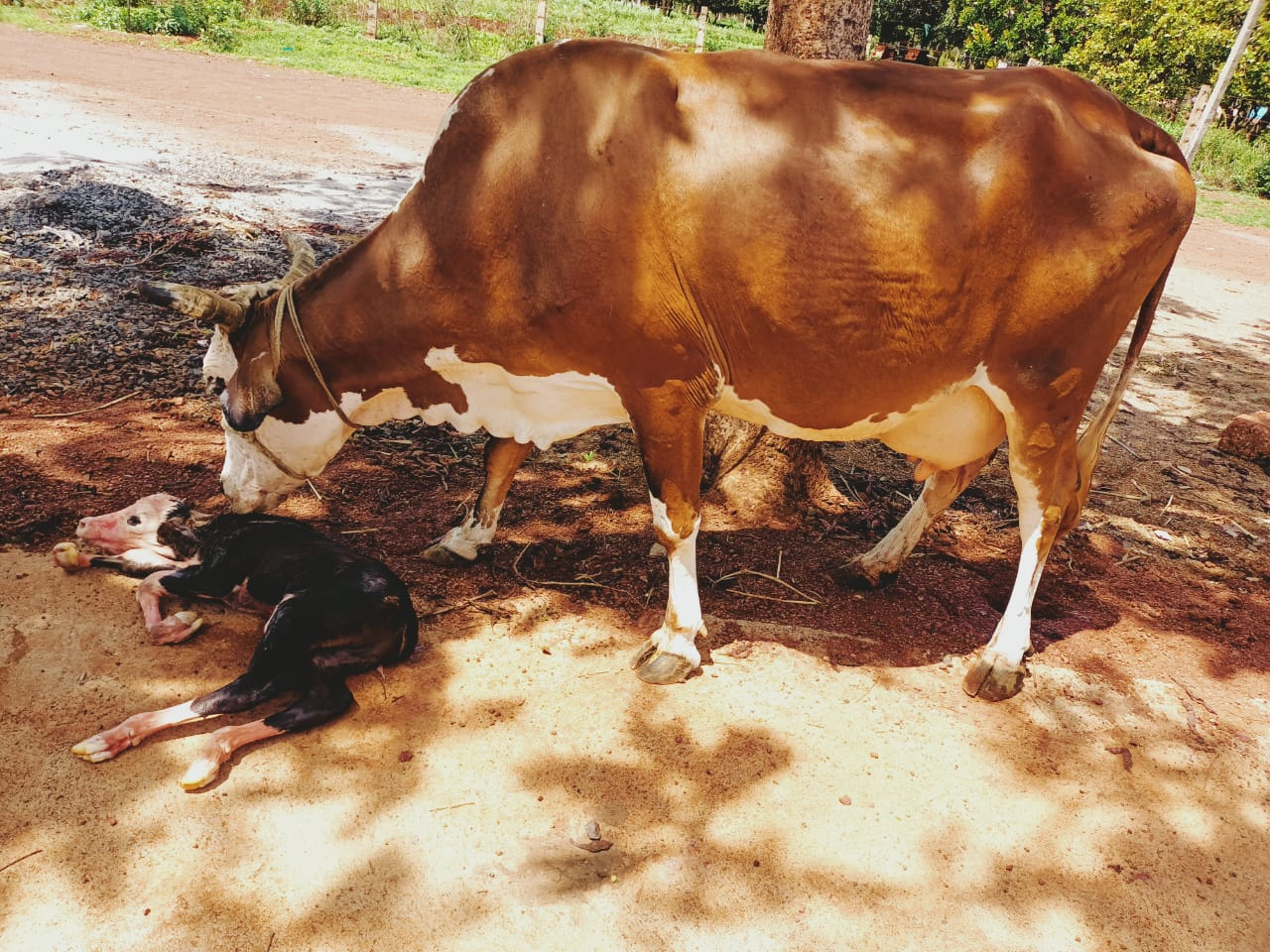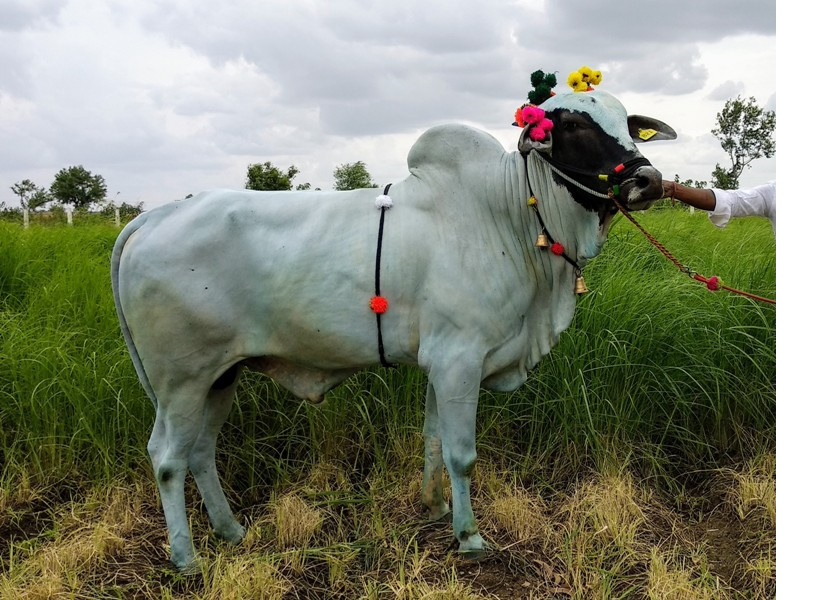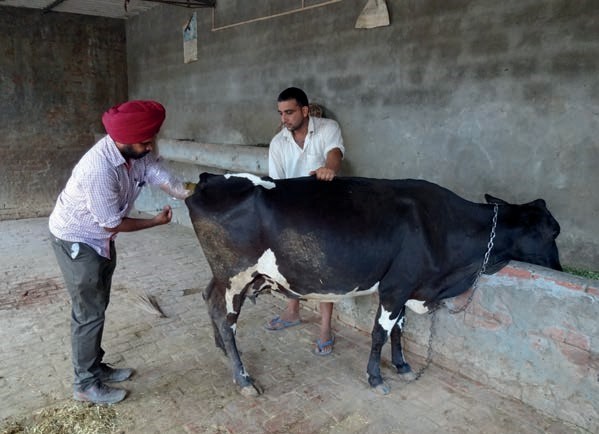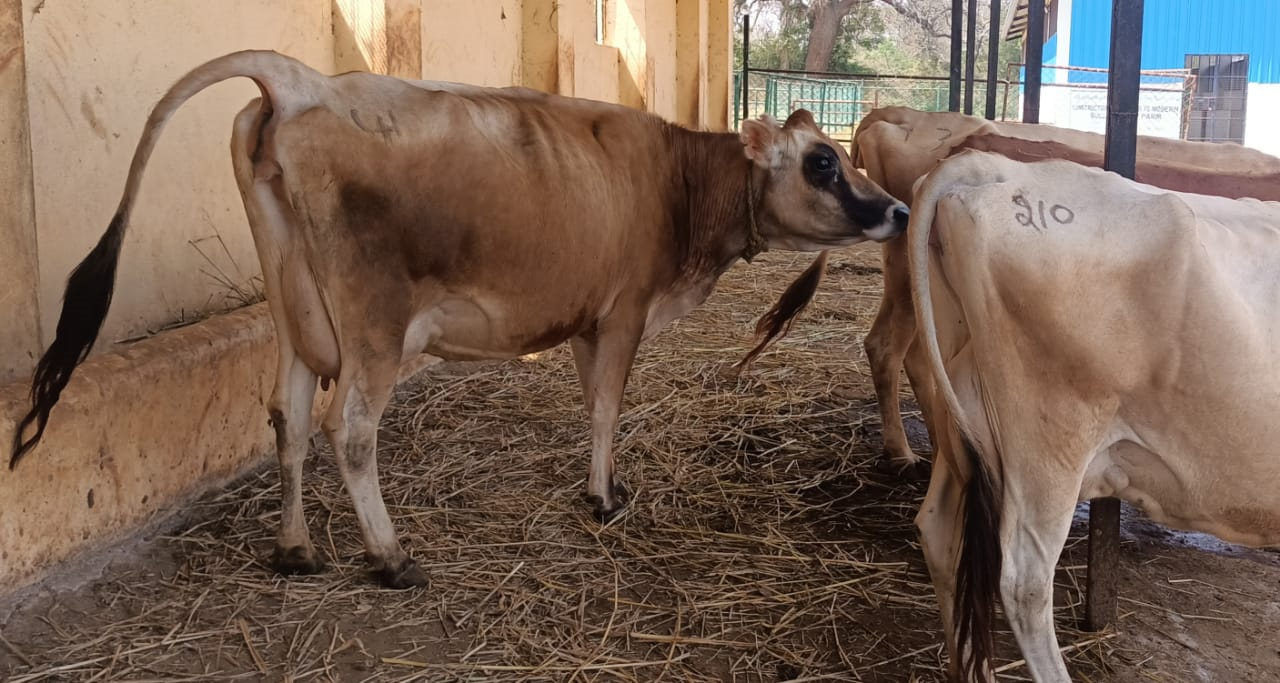Reproduction And Artificial Insemination
Selection for breeding
Heifers
Cows
Most important economic trait to be looked into, while selecting a cow is 'milk production'. The present average daily milk production of the cross breed cows is around 5.5 liters. For economic milk production a cow producing not less than 2500 kg milk in 305 days lactation period is desirable. In general, selecting a newly calved cow yielding ten liters per day may have 2000-2500 kg lactation yield and cow yielding 15 liters per day initially may have a lactation yield of 3000 kg. A peak yield of at least 12 kg milk per day can be used as a criterion for this. Age at first calving should be less than 3 years. The interval between two successive calving should be 12 to 15 months. The cow should not have any physical deformity and should possess dairy conformation like well developed udder, prominent milk vein, squarely placed teats, ease in milking and good temperament. Unproductive cows are to be replaced by young cows. The calves reared in the farm itself are usually used for replacement. Normally, 20 percent of the stock has to be replaced each year. When calves are insufficient or when the general performance of the herd is poor, cows from outside can be purchased and added to the herd.

Bulls
Bulls contribute 50 percent of the inheritance to the next generation. Most of the genetic improvement in a population comes through proper bull selection. It is not very practicable to have intense selection of the females for breeding i.e., almost all the heifers will have to be reared and used for breeding in a situation where age at first calving and calving interval are not optimum. Hence most care is to be given for bull selection. To achieve the goal of average 305 days milk yield of 2500 kg and above per lactation, the bulls used should be proven bulls or of high pedigree. The young bulls used for breeding should be from dams with lactation milk production not less than 4500 kg and bulls with higher sire index. Other economic traits like milk fat and SNF, age at first calving, calving ease, incidence of diseases etc., should be included in evaluation.
Bulls contribute 50 percent of the inheritance to the next generation. Most of the genetic improvement in a population comes through proper bull selection. It is not very practicable to have intense selection of the females for breeding i.e., almost all the heifers will have to be reared and used for breeding in a situation where age at first calving and calving interval are not optimum. Hence most care is to be given for bull selection. To achieve the goal of average 305 days milk yield of 2500 kg and above per lactation, the bulls used should be proven bulls or of high pedigree. The young bulls used for breeding should be from dams with lactation milk production not less than 4500 kg and bulls with higher sire index. Other economic traits like milk fat and SNF, age at first calving, calving ease, incidence of diseases etc., should be included in evaluation.

Deoni Bull
Cattle Breeding
Cattle’s rearing is an important subsidiary to agriculture in India. It has been playing a significant role in India's rural economy. Despite of vast cattle population, India's place regarding cattle productivity is at the rock-bottom vis-a-vis other countries, especially western ones. One of the major reasons for this is the lack of good breeding stock as well as technologies in our villages. The following points describes different aspects of scientific breeding of cattle and buffaloes.
I. Introduction
Reproduction is an important consideration in the economics of cattle production. In the absence of regular breeding and calving at the appropriate time cattle rearing will not be profitable. A healthy calf each year is the usual goal. This is possible only by increasing the reproductive efficiency of the animals.
Successful reproduction encompasses the ability to mate, the capacity to conceive and to nourish the embryo and deliver the viable young ones at the end of a normal gestation period. In fact, interruption in this chain of events leads to failure of the cow either to conceive or the embryo to die or to have a premature delivery of the foetus.
The reproductive efficiency is a complex phenomenon controlled by both genetic and non-genetic factors, the non- genetic factors being climate, nutrition, and level of management. The reproductive efficiency varies not only between species and breeds but also among the animals within the same breed. Improving the genetic merits of livestock populations is important at all levels of management. A sound breeding programme is a necessary part of the total animal production system. It is absolutely imperative to improve the productive capacity and physical appearance of the animal population.
II. Factors Affecting Breeding Efficiency
The factors which influence the breeding efficiency of cattle are as follows:
1. Number of ova
The first limitation on the breeding efficiency of fertility of an animal is the number of functional ova released during each cycle of ovulation. Ovulation is the process of shedding of ovum from the Graffian follicle. In the case of cow, usually a single ovum is capable of undergoing fertilization only for a period of 5-10 hours. Therefore, the time of mating in relation to ovulation is important for effective fertilization.
2. Percentage of fertilization
The second limitation is fertilization of ova. Failure to be fertilized may result from several causes. The spermatozoa may be few or low in vitality. The service may be either too early or too late. so that the sperms and eggs do not meet at the right moment, to result in fertilization.
3. Embryonic death
From the time of fertilization till birth, embryonic mortality may occur due to a variety of reasons. Hormone deficiency or imbalance may cause failure of implantation of fertilized ova which die subsequently. Death may occur as a result of lethal genes for which the embryos are homozygous. Other causes may be accidents in development, over-crowding in the uterus, insufficient nutrition or infections in tile uterus.
4. Age of first pregnancy
Breeding efficiency may be lowered seriously by increasing the age of first breeding. Females bred at a lower age are likely to appear stunted during the first lactation, but their mature size is affected little by their having been bred early.
5. Frequency of pregnancy
The breeding efficiency can be greatly enhanced by lowering the interval between successive pregnancies. The wise general policy is to breed for the first time at an early age and to rebreed at almost the earliest opportunity after each pregnancy. In this way the lifetime efficiency is increased. Cows can be rebred in 9-12 weeks after parturition.
6. Longevity
The length of life of the parent is an important part of breeding efficiency, because the return over feed cost is greater in increased length of life. Also, it affects the possibility of improving the breed. The longer the life of the parents, the smaller the percentage of cows needed for replacement every year.
III. Management Practices to Improve Breeding Efficiency
Some of the management suggestions which will tend to improve breeding efficiency of cattle are listed below.
- Keep accurate breeding records of dates of heat, service and parturition. Use records in predicting the dates of heat and observe the females carefully for heat.
- Breed cows near the end of heat period.
- Have females with abnormal discharges examined and treated by veterinarian.
- Call a veterinarian to examine females not settled after three services.
- Get the females checked for pregnancy at the proper time after breeding.
- Buy replacements only from healthy herds and test them before putting them in your herd
- Have the females give birth in isolation, preferably in a parturition room and clean up and sterilize the area once parturition is over.
- Follow a programme of disease prevention, test and vaccination for diseases affecting reproduction and vaccinate the animals against such diseases.
- Practice a general sanitation programme.
- Supply adequate nutrition.
- Employ the correct technique.
- Provide suitable shelter management.
- Detect silent or mild heat, by using a teaser bull
Artificial Insemination: Better Semen for Better Calves
Artificial insemination is the technique in which semen with living sperms is collected from the male and introduced into female reproductive tract at proper time with the help of instruments. This has been found to result in a normal offspring. In this process, the semen is inseminated into the female by placing a portion of it either in a collected or diluted form into the cervix or uterus by mechanical methods at the proper time and under most hygienic conditions. The first scientific research in artificial insemination of domestic animals was performed on dogs in 1780 by the Italian scientist, Lazanno Spalbanzani. His experiments proved that the fertilizing power reside in the spermatozoa and not in the liquid portion of semen. Few further studies under research station conditions helped this technique to be used commercially allover the world including India.
Artificial insemination is not merely a novel method of bringing about impregnation in females. Instead, it is a powerful tool mostly employed for livestock improvement. In artificial insemination the germplasm of the bulls of superior quality can be effectively utilized with the least regard for their location in far away places. By adoption of artificial insemination, there would be considerable reduction in both genital and non-genital diseases in the farm stock.
- Artificial insemination (AI) is the deposition of semen into the female genital tract by means of instruments.
- The germplasm of bulls of superior quality can be utilized.
- Look for mothers’ milk yield of bull to decide about the superiority of the bull.
- AI reduces both genital and non-genital diseases in the farm stock.
- Non-descript cattle in the semi-arid tropics can be upgraded using exotic/crossbred bulls’ semen, which would help in increasing milk production and farmers’ income.
- Sorted sexed semen has become an innovative technology that can produce mostly female calves for breeds of choice.
- The farmers must know the right time of AI i.e 12-18 hours after the onset of heat.
- A simple method is to get the cow/buffalo inseminated in the evening if it is showing heat symptoms in morning and in the next day morning if it is showing heat symptoms in the evening.

Artificial insemination by a veterinarian
Symptoms of Heat
The various symptoms of heat are
- The animal will be excited condition. The animal will be in restlessness and nervousness.
- The animal will be bellowing frequently.
- The animal will reduce the intake of feed.
- Peculiar movement of limbo sacral region will be observed.
- The animals which are in heat will lick other animals and smelling other animals.
- The animals will try to mount other animals
- The animals will standstill when other animal try to mount.. This period is known as standing heat. This extends 14-16 hours.
- Frequent maturation (urination) will be observed.
- Clear mucous discharge will be seen from the vulva, sometimes it will be string like the mucous will be seen stick to the near the pasts of valva.
- Swelling of the valva will be seen.
- Congestion and hyperemia of membrane.
- The tail will be in raised position.
- Milk production will be slightly decreased.
- On Palpation uterus will be turgid and the cervix will be opened.

Advantages of Artificial Insemination:
There are several advantages by artificial insemination over natural mating or servicing.
- There is no need of maintenance of breeding bull for a herd; hence the cost of maintenance of breeding bull is saved.
- It prevents the spread of certain diseases and sterility due to genital diseases.
- Eg: contagious abortion, vibriosis.
- By regular examination of semen after collection and frequent checking on fertility make early detection of interior males and better breeding efficiency is ensured.
- The progeny testing can be done at an early age.
- The semen of a desired sire can be used even after the death of that particular sire.
- The semen collected can be taken to the urban areas or rural areas for insemination.
- It makes possible the mating of animals with great differences in size without injury to either of the animal.
- It is helpful to inseminate the animals that refuse to stands or accept the male at the time of oestrum.
- It helps in maintaining the accurate breeding and calving records.
- It increases the rate of conception.
- It helps in better record keeping.
- Old, heavy and injured sires can be used.
Disadvantages of A.I:
- Requires well-trained operations and special equipment.
- Requires more time than natural services.
- Necessitates the knowledge of the structure and function of reproduction on the part of operator.
- Improper cleaning of instruments and in sanitary conditions may lead to lower fertility.
- If the bull is not properly tested, the spreading of genital diseases will be increased.
- Market for bulls will be reduced, while that for superior bull is increased.
A practical recommendation for timing of insemination
| Cows showing estrus | Should be inseminated | Tool late for good results | |||
|---|---|---|---|---|---|
| In morning | Same day | Next day | |||
| In afternoon | Morning of next day or early afternoon | After 3 p.m. | |||
| It is advised to inseminate the animals within 8 to 12 hours after showing estrous symptoms | |||||
Semen Collection Methods and Evaluation:
Various methods of collection of semen have been devised from time to time. The older unsatisfactory methods have gradually replaced by the new modern techniques.
There are three common methods.
- Use of artificial vagina
- By Electro-stimulation method.
- By massaging the ampulae of the duct us differences through rectal wall.
- The ideal method of semen collection is use of artificial vagina which is safe for sire and the collector also
Artificial Vagina Method
The artificial vagina has the following parts:
- A heavy hard rubber 2" lose, open at both ends with a nostle for air and water in and outlet.
- Inner sleeve of rubber or rubber liner.
- The semen receiving cone or rubber cone.
- Semen collection tube made of glass or plastic graduate in cc and its fraction correct to 0.1 CC
- Before using for semen collection, all the parts are washed thoroughly and sterilized properly, and assembled as artificial vagina, the rubber liner is inserted into the hose; inverting both ends back by folding back from either side opening, or fastening with rubber bands. Now the space between the hard rubber hose and inner rubber liner forms a water tight compartment. The nostle at one end of the hose can be fixed.
Parts of Artificial Vagina
Turning through the threaded nut up or down. The water jacket of the Artificial -vagina is- filled with hot water at a temperature of 45°C (113°F) by opening the nostle. The graduated semen collection tube is fixed to the narrow end of the artificial vagina hose, and fastened by a rubber band. The inner side of the rubber liner on the anterior side of the artificial vagina is lubricated with sterile jelly to a length of 3 to 4 inches. Air is blown through the nostle into the water jacket, to create pressure in if, and the same is exerted the rubber linear, to simulate natural vagina.
The temperature of the artificial vagina is to be checked, at each collection, and it should simulate natural vagina at mounting time. If the artificial vagina is to mount later. If it is too cold ejaculate may not be there after a thrust, or even if ejaculate is there; it may be contaminated with urine, and becomes unfit for use.
Semen Collection Method. (A.V.)
The cow or dummy is secured in service create. The artificial vagina assembled is held at 45° angle from the direction of penis, and the thrust is that angle. The artificial vagina is held with the left hand by a right handed person; and when the bull mounts the cow, the sheath of the bull will be graphed by the operator, directing the gland penis into the artificial vagina, and then the bull gives a thrust to ejaculate.
The operator should evince care so as not to touch the exposed past of the penis. After the bull dismounts, the artificial vagina is taken off from penis and the air vent is opened to release the pressure from the jacket.
The water from the jacket is also drained by opening the nostle. This allows the ejaculate to flow from the cone to the semen collection tube. The semen collection tube is detached from the cone, plugged with cotton wool, and taken to the laboratory for examination. The rubber cone and the semen collection tube can be protected from external contamination or heat or higher, by covering with an insulation bag with zip.
Semen Storage
The discovery that bull semen could be successfully frozen and stored for indefinite periods has revolutionized AI in cattle. In 1949, British scientists discovered that addition of glycerol to the semen extender improved resistance of sperm to freezing. Glycerol acts to remove water from the sperm cell prior to freezing and prevents the formation of cellular ice crystals which would damage the sperm. There are two methods of freezing and storing semen: dry ice and alcohol (-100 degrees F) and liquid nitrogen (-320 degrees F). Liquid nitrogen is preferred because there is no evidence of fertility deterioration with age. Fertility gradually declines in semen stored in dry ice-alcohol.
Fresh, liquid semen can be successfully stored for 1 to 4 days at 400° F. Semen is usually stored in glass ampoules. Other methods appear promising, particularly the French-straw. Several AI organizations have gone to this method exclusively. Artificial coloring is frequently added to semen extenders in order to distinguish one breed from another. Complete identification of the bull is required on each individual semen container.
Insemination Methods
There-are different methods insemination in different species of animals i.e. speculum method, vaginal method and recto vaginal method.
Recto Vaginal Method
In cattle the safe and best method of insemination is “Recto vaginal method of insemination”. Animal which is in heat is well controlled by placing it in a Travis. The inseminator will get ready by wearing a plastic apron, gumboots and gloves. The semen straw after thawing (keeping the semen straw in warm water for a minute to convert the freezed semen into liquid and the sperms become motile) is loaded in a sterilized A.I. gun and is covered with a plastic sheath. The inseminator will insert the gloved left hand into the rectum after applying the soft soap or other lubricant on the glove and back racked the animal, and the hand is further inserted and will catch hold the cervix through rectal wall. The A.I gun loaded with semen straw is passed.
Through the vulva to ‘vagina and cervix and observed with the hand in rectum that the A. I gun reaches the cervix, then the semen is deposited by injecting the gun, and after depositing the semen, the gun is removed, the empty straw and sheath are disordered.
Spectrum Method
In this method, spectrum is placed in the vagina of the cow, which provides passage outside the site of insemination, then inseminating tube is passed through the speculum and semen is deposited at the cervix insemination method.
Vaginal Method
Hand is passed through the vagina and the inseminating tube is guided by hand to the site of insemination and semen is deposited. Here there is a risk of contamination and injury of female genitalia.
Frozen Semen and Storage
Freezing of semen for successful preservation of spermatozoa, for long periods, is of great importance in livestock breeding and farm management. It has made it possible” to make available the use of outstanding proven sires for larger number of cows, covering larger area, frozen semen shipment has become possible to different continents in the globe to any place connected with any service. Now a day if farmer wants to use of an outstanding sire for inheritance of high milk yield, he can go in for frozen semen service provided his area is, covered by Artificial insemination, with supply of frozen semen. At present frozen semen is used in most of the states in India. Liquid nitrogen plays a vital role for storing the frozen semen straws, at a temperature of -196°C for longer periods.

